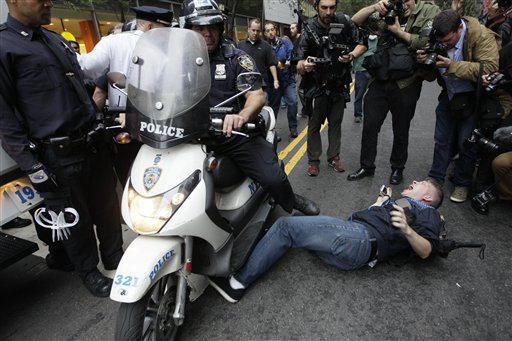|
A news photo shot by AP photographer Mary Altaffer showing a New York City police officer running over a Legal Aid Society observer as Occupy Wall Street demonstrators march through the streets near Wall Street on Friday, October 14, 2011 is a very interesting depiction of these events:

This image offers an encapsulation of the role that the media have in these events, and how important media coverage is for both sides of these protests: depending on how this picture is framed in a discussion, it is possible to create an entirely different story:
In one, it is the "protester" who is at fault, whose actions are a result of attempting to disrupt the proper police action, resulting in the accident shown in this photograph.
For the other story, it is police who are at fault, idly standing by, and whose actions are provocations of resistance. It is the police who do not respond appropriately.
Each narrative is supported to some extent by this photograph; in both stories, what is happening is unacceptable. The difference lies with who is being blamed for what is shown: the authorities, or those protesting, resisting. The choice of one story or another is informative about the biases and which narrative (one that supports the status quo, or one that challenges it) is being embraced by the image's interpreter. That this picture appears to come from the instant that the man is run over, the driver's lack of response may not mean much: without more information we cannot say what happened before or after from this image alone, which is what makes it such a useful mirror for locating and recognizing the bias of its examiners and interpreters.
Being an instant of time, it cannot answer if the man was run over intentionally, threw himself under the motorcycle, or what was happening; never the less, it has the potential to become an iconic representation of what happened during the Occupy Wall Street protests...
|